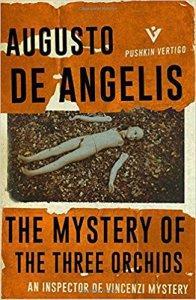The Mystery of the Three Orchids, by Augusto De Angelis and translated by Jill Foulston
When it came down to it he was sentimental, and he had an instinctive respect for the dead, for scoundrels who’d once been alive.
I read this one back in early July so it’s a little unfair to review it now. It’s not a book that’s really intended to linger in the memory; it’s an afternoon’s light entertainment.
This is the third of De Angelis’ vintage Italian crime novels published by Pushkin’s Vertigo imprint. It features once again his Inspector De Vincenzi, whose efficiency I continue to doubt. I’ve read all three novels now and I can’t help but think that if De Vincenzi were a little more diligent the body count in these books would be much lower.

This time the action takes place in a Milan fashion house, which is about as good a setting as one could hope for. The house’s American owner Cristiana O’Brien discovers the dead body of her general dogsbody Valerio laid out on her bed and a single orchid placed where she can’t fail to see it. The orchid has a sinister significance for her, though we’ll have to wait to find out why.
Soon De Vincenzi is on the scene and not before time because there’s a fair few suspects to work through:
- Cristiana herself, whom we immediately learn has a dark secret and shady past that she dearly needs to hide;
- “Prospero O’Lary, the administrative secretary of the business” who looks like “a black tortoise ill with meningitis”;
- the bronzed fashion designer Madame Firmino who can’t bear the rich women who buy her creations, each of which is created for willowy models but worn by flabby society women;
- Evelina the immensely fat and rather diligent bookkeeper whom De Vincenzi immediately takes a liking to since “You can’t weigh more than a hundred kilos without having a correspondingly light conscience!”;
- a glamorous former American bank robber who “looked like a rich peasant, with a red birthmark on his forehead, ruddy blond hair, a solid chest and the sweet and innocent expression of a man used to living in the open air”;
- the bank robber’s beautiful sister with a “a pretty little tabby cat’s face” and eyes which “had the clean lines of almonds, with glowing green irises”; and
- of course, the models themselves Irma, Gioia, Anna, Clara none of whom seem particularly supportive of each other.
Phew! For a short book it’s fairly packed with larger than life characters. Of course the bodies (and accompanying orchids) soon start to stack up, which is handy really as it’s one of the few things that seems to help De Vincenzi narrow down the list of suspects. He is disadvantaged though by almost all the suspects being women, since:
He knew that a sudden, unexpected question can take a man by surprise, but a woman, never. Lying and distraction come easily to women; their deviousness is automatic.
And later…
How could one distinguish truth from false-hood in a woman’s statements, and how could one find logic in her words and actions?
Ahem. Well, it was written in 1942 so I think you just have to make the occasional allowance for period.
The previous two novels suffered a little from an excess of portentous dialog about how terrible and shocking the crimes were. There’s a bit of that here: “Listen to me, Signora. What has happened in this house over the last ten hours isn’t only tragic, it’s frightening, grotesque and absurd.” Generally though it’s lighter touch than the previous books and better for it.
Over at his blog Stu compared this to “those great american crime radio dramas where the crime is all wrapped neatly up in half an Hour” which I really like as an analysis. It captures the book’s strength which is that it’s fun, a bit frothy and a quick read. It’s what Emma of Bookaround might describe as a beach and public transport book.
There’s not a lot more to say really. Obviously I don’t want to spoil the plot which builds up as you’d expect to the ultimate reveal by the detective where he confronts the culprit in front of a roomful of people and sets out the chain of evidence that proves their guilt (though as ever any decent lawyer could probably knock a good few holes in it however right the detective may be).
It’s a very traditional crime novel, but set in a fun period and milieu. For me the De Angelis novels are a slightly odd choice for Pushkin Press who usually opt for more challenging material. Still, they merit rediscovery and nobody else is publishing them in translation so why not?
Other reviews
Stu, as mentioned above, reviewed it at Winston’s Dad’s Blog here. Guy also reviewed it at His Futile Preoccupations here. Guy had this as his favorite of the De Angelis, though for me I think that would be The Hotel of the Three Roses which has an even better cast than this and which I actually remember better despite reading far longer ago.
Filed under: Crime Fiction, De Angelis, Augusto, Italian Literature, Pushkin Vertigo Tagged: Augusto De Angelis

